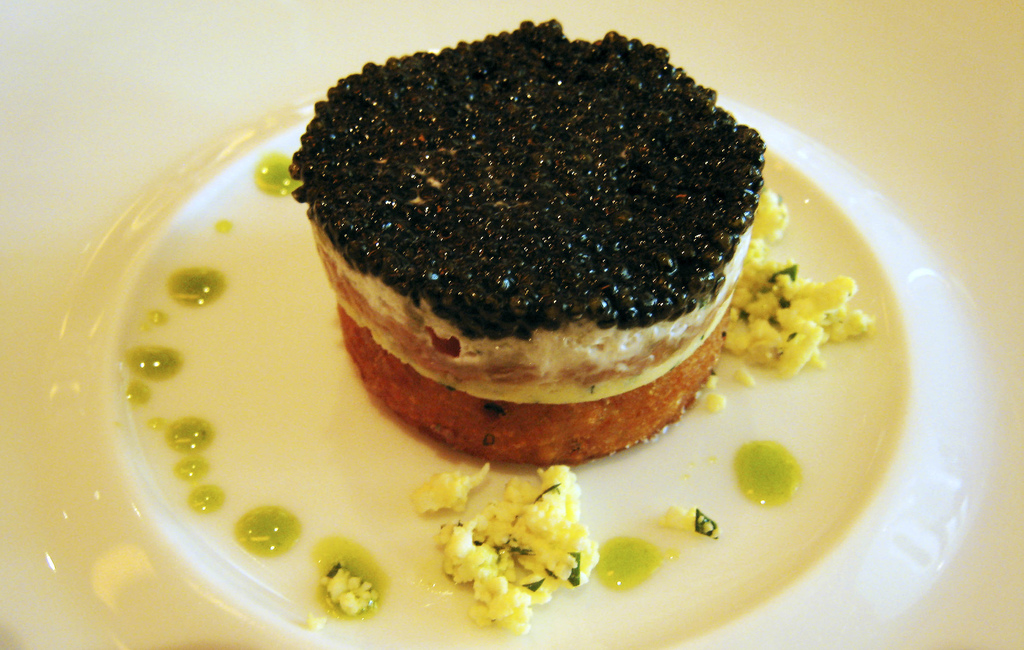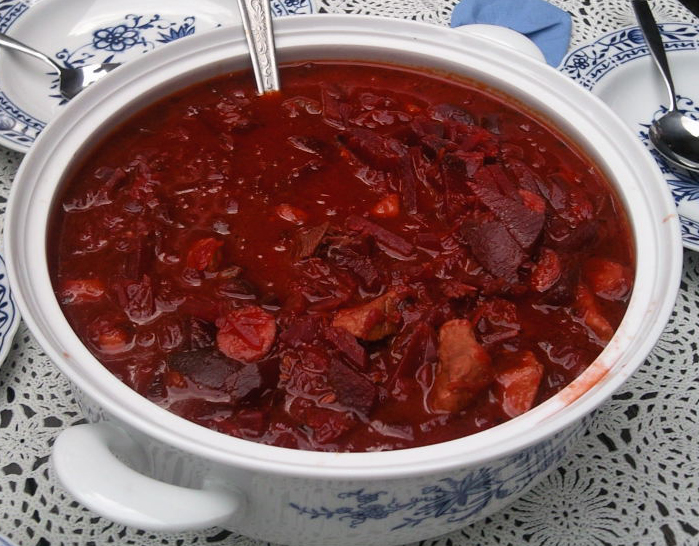|
Rassolnik
Rassolnik (russian: рассольник) is a traditional Russian soup made from pickled cucumbers, pearl barley, and pork or beef kidneys. A vegetarian variant of rassolnik also exists, usually made during Lent. The dish is known to have existed as far back as the 15th century, when it was called ''kalya''. Rassolnik became part of the common Soviet cuisine and today it is also popular in Ukraine and Belarus. A similar dish is common in Poland, where it is known as '' zupa ogórkowa'' (literally ''cucumber soup''). The key part of rassolnik is the ''rassol'', a liquid based on the juice of pickled cucumbers with various other seasonings. It is a favourite hangover treatment. See also * Borshch * Shchi * Solyanka * List of Russian dishes * List of soups This is a list of notable soups. Soups have been made since Ancient history, ancient times. Some soups are served with large chunks of meat or vegetables left in the liquid, while others are served as a broth. A ... [...More Info...] [...Related Items...] OR: [Wikipedia] [Google] [Baidu] |
List Of Soups
This is a list of notable soups. Soups have been made since Ancient history, ancient times. Some soups are served with large chunks of meat or vegetables left in the liquid, while others are served as a broth. A broth is a flavored liquid usually derived from boiling a type of meat with bone, a spice mix, or a vegetable mix for a period of time in a Stock (food), stock. A potage is a category of thick soups, stews, or porridges, in some of which meat and vegetables are boiled together with water until they form a thick mush. Bisque (food), Bisques are heavy cream soups traditionally prepared with shellfish, but can be made with any type of seafood or other base ingredients. Cream soups are dairy based soups. Although they may be consumed on their own, or with a meal, the canned, condensed form of cream soup is sometimes used as a quick sauce in a variety of meat and pasta convenience food dishes, such as casseroles. Similar to bisques, chowders are thick soups usually containi ... [...More Info...] [...Related Items...] OR: [Wikipedia] [Google] [Baidu] |
List Of Russian Dishes
This is a list of notable dishes found in Russian cuisine. Russian cuisine is a collection of the different cooking traditions of the Russian Empire. The cuisine is diverse, with Northeast European/Baltic, Caucasian, Central Asian, Siberian, East Asian and Middle Eastern influences. Russian cuisine derives its varied character from the vast and multi-ethnic expanse of Russia. Russian dishes Zakuski Soups Salads Meat dishes Pancakes Bread Pirogi (pies) Sauces Desserts Beverages Non-alcoholic drinks Alcoholic drinks See also * Khrushchev dough * Mikoyan cutlet * List of Russian desserts * List of Russian restaurants * Russian candy Russian candy ( fi, kinuski; russian: ки́нуски ''kinuski'') is a very sweet toffee-like dessert made by carefully heating equal amounts of milk or cream and sugar. It is a traditional dessert sauce in Nordic countries. Karl Fazer K ... References Bibliography * {{DEFAULTSORT:Russian Dishes Lists ... [...More Info...] [...Related Items...] OR: [Wikipedia] [Google] [Baidu] |
Russian Soups
Russian cuisine is a collection of the different dishes and cooking traditions of the Russian people as well as a list of culinary products popular in Russia, with most names being known since pre-Soviet times, coming from all kinds of social circles. History The history of Russian cuisine was divided in four groups: Old Russian cuisine (ninth to sixteenth century), Old Moscow cuisine (seventeenth century), the cuisine that existed during the ruling of Peter and Catherine the Great (eighteenth century), and finally Petersburg cuisine, which took place from the end of the eighteenth century to the 1860s. In the Old Russian period, the main food groups were bread, lots of grains, and lots of foods that contained starch. Women baked pies with lots of different fillings, such as mushrooms or berries. During gatherings, a loaf of bread and salt was always present. Kasha, such as buckwheat, oats, etc.were represented as wellbeing to the household. Lots of Russians used honey and ... [...More Info...] [...Related Items...] OR: [Wikipedia] [Google] [Baidu] |
Solyanka
Solyanka (russian: соля́нка, initially ''селя́нка''; in English "Settlers' Soup") is a thick and sour soup of Russian origin that is common in Russia, Ukraine, Belarus, and other states of the former Soviet Union and certain parts of the former Eastern Bloc. It was one of the most popular dishes of the former East Germany (german: Soljanka(-Suppe)). Overview There are three basic types of solyanka, with the main ingredient being either meat, fish, or mushrooms. All of them contain pickled cucumbers with brine, and often cabbage, salted mushrooms, potatoes, smetana (sour cream), and dill. The soup is prepared by cooking the cucumbers with brine before adding the other ingredients to the broth. * For meat solyanka, ingredients like beef, ham, sausages, chicken breast together with cucumber pickles, tomatoes, onions, olives, capers, allspice, parsley, and dill are all cut fine and mixed in a pot. The broth is added, and heated for a short time on the stove, wit ... [...More Info...] [...Related Items...] OR: [Wikipedia] [Google] [Baidu] |
Shchi
Shchi ( rus, щи, p=ɕːi, a=Ru-щи.ogg) is a Russian-style cabbage soup. When sauerkraut is used instead, the soup is called sour shchi, while soups based on sorrel, spinach, nettle, and similar plants are called green shchi (russian: зелёные щи, ''zelionyje shchi''). In the past, the term ''sour shchi'' was also used to refer to a drink, a variation of kvass, which was unrelated to the soup. History Shchi (from orv, съти, the plural of "''съто''" (s(i)to) - "something satisfying, feed") is a traditional soup of Russia. Cabbage soups have been known in Kievan Rus as far back as the 9th century, soon after cabbage was introduced from Byzantium. Its popularity in Russia originates from several factors. Shchi is relatively easy to prepare; it can be cooked with or without various types of meat; and it can be frozen and carried as a solid on a trip to be cut up when needed. As a result, by the 10th century shchi became a staple food of Russia, and a popular ... [...More Info...] [...Related Items...] OR: [Wikipedia] [Google] [Baidu] |
Soviet Cuisine
Soviet cuisine, the common cuisine of the Soviet Union, was formed by the integration of the various national cuisines of the Soviet Union, in the course of the formation of the Soviet people. It is characterized by a limited number of ingredients and simplified cooking. This type of cuisine was prevalent in canteens everywhere in the Soviet Union. It became an integral part of household cuisine and was used in parallel with national dishes, particularly in large cities. Generally, Soviet cuisine was shaped by Soviet eating habits and a very limited availability of ingredients in most parts of the USSR. Most dishes were simplifications of French, Russian, Austro- Hungarian cuisines, and cuisines from other Eastern Bloc nations. Caucasian cuisines, particularly Georgian cuisine, contributed as well. Canteens run by the government were called stolovaya. [...More Info...] [...Related Items...] OR: [Wikipedia] [Google] [Baidu] |
Russia
Russia (, , ), or the Russian Federation, is a transcontinental country spanning Eastern Europe and Northern Asia. It is the largest country in the world, with its internationally recognised territory covering , and encompassing one-eighth of Earth's inhabitable landmass. Russia extends across eleven time zones and shares land boundaries with fourteen countries, more than any other country but China. It is the world's ninth-most populous country and Europe's most populous country, with a population of 146 million people. The country's capital and largest city is Moscow, the largest city entirely within Europe. Saint Petersburg is Russia's cultural centre and second-largest city. Other major urban areas include Novosibirsk, Yekaterinburg, Nizhny Novgorod, and Kazan. The East Slavs emerged as a recognisable group in Europe between the 3rd and 8th centuries CE. Kievan Rus' arose as a state in the 9th century, and in 988, it adopted Orthodox Christianity from the ... [...More Info...] [...Related Items...] OR: [Wikipedia] [Google] [Baidu] |
Brine (food)
In food processing, brining is treating food with brine or coarse salt which preserves and seasons the food while enhancing tenderness and flavor with additions such as herbs, spices, sugar, caramel or vinegar. Meat and fish are typically brined for less than twenty-four hours while vegetables, cheeses and fruit are brined in a much longer process known as pickling. Brining is similar to marination, except that a marinade usually includes a significant amount of acid, such as vinegar or citrus juice. Brining is also similar to curing, which usually involves significantly drying the food, and is done over a much longer time period. Meat Brining is typically a process in which meat is soaked in a salt water solution similar to marination before cooking. Meat is soaked anywhere from 30 minutes to several days. The amount of time needed to brine depends on the size of the meat: more time is needed for a large turkey compared to a broiler fryer chicken. Similarly, a large roast must ... [...More Info...] [...Related Items...] OR: [Wikipedia] [Google] [Baidu] |
Borshch
Borscht () is a sour soup common in Eastern Europe and Northern Asia. In English, the word "borscht" is most often associated with the soup's variant of Ukrainian origin, made with red beetroots as one of the main ingredients, which give the dish its distinctive red color. The same name, however, is also used for a wide selection of sour-tasting soups without beetroots, such as sorrel-based green borscht, rye-based white borscht, and cabbage borscht. Borscht derives from an ancient soup originally cooked from pickled stems, leaves and umbels of common hogweed (''Heracleum sphondylium''), a herbaceous plant growing in damp meadows, which lent the dish its Slavic name. With time, it evolved into a diverse array of tart soups, among which the Ukrainian beet-based red borscht has become the most popular. It is typically made by combining meat or bone stock with sautéed vegetables, which – as well as beetroots – usually include cabbage, carrots, onions, potatoes, and ... [...More Info...] [...Related Items...] OR: [Wikipedia] [Google] [Baidu] |
Hangover
A hangover is the experience of various unpleasant physiological and psychological effects usually following the consumption of alcohol, such as wine, beer, and liquor. Hangovers can last for several hours or for more than 24 hours. Typical symptoms of a hangover may include headache, drowsiness, concentration problems, dry mouth, dizziness, fatigue, gastrointestinal distress (e.g., vomiting, diarrhea), absence of hunger, light sensitivity, depression, sweating, nausea, hyper-excitability, irritability, and anxiety. While the causes of a hangover are still poorly understood, several factors are known to be involved including acetaldehyde accumulation, changes in the immune system and glucose metabolism, dehydration, metabolic acidosis, disturbed prostaglandin synthesis, increased cardiac output, vasodilation, sleep deprivation, and malnutrition. Beverage-specific effects of additives or by-products such as congeners in alcoholic beverages also play an important role. The sympt ... [...More Info...] [...Related Items...] OR: [Wikipedia] [Google] [Baidu] |
Poland
Poland, officially the Republic of Poland, , is a country in Central Europe. Poland is divided into Voivodeships of Poland, sixteen voivodeships and is the fifth most populous member state of the European Union (EU), with over 38 million people, and the List of European countries by area, seventh largest EU country, covering a combined area of . It extends from the Baltic Sea in the north to the Sudetes and Carpathian Mountains in the south, bordering seven countries. The territory is characterised by a varied landscape, diverse ecosystems, and Temperate climate, temperate transitional climate. The capital and List of cities and towns in Poland, largest city is Warsaw; other major cities include Kraków, Wrocław, Łódź, Poznań, and Gdańsk. Prehistory and protohistory of Poland, Humans have been present on Polish soil since the Lower Paleolithic, with continuous settlement since the end of the Last Glacial Period over 12,000 years ago. Culturally diverse throughout ... [...More Info...] [...Related Items...] OR: [Wikipedia] [Google] [Baidu] |






_-_Foto_Giovanni_Dall'Orto%2C_6-Dec-2007-cropped.jpg)